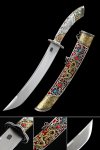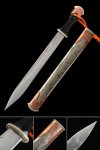Explore the mystique and craftsmanship of Tibetan Knives, where tradition meets artistry in each meticulously crafted blade. Our collection of Tibetan Knives offers a unique blend of cultural heritage and functional design, perfect for both collectors and enthusiasts of traditional weaponry. Each knife is forged with precision and care, using high-quality materials to ensure durability and exceptional performance. These knives are not only tools but also pieces of art that reflect the rich history and spiritual significance of Tibetan culture. Whether you are a seasoned collector or a newcomer to the world of traditional knives, our Tibetan Knives will captivate your interest and inspire your passion. Discover the perfect Tibetan Knife in our selection and connect with the timeless legacy of this ancient craft.
Good quality Knife, heavy and well finished with a nicely decorated sheath.r
Thank you.
 |
Antique Tibetan Knife, Double Edge Blade Knife |
The item arrived quickly and is beautiful.r
Thanks you very much!r
r
Kind regards,r
C.Q.Pham
 |
Chinese Tibet Short Sword (雪域藏刀) |
The Tibetan design of this blade is absolutely beautiful.I love the inscription in the Tibetan dialect on the base of the blade just above the handle.It is sharp and battle ready,so it’s no display piece.It’s is a very nice product that I don’t regret buying at all.10/10
 |
Antique Tibet Knife, Double Edge Blade Knife |